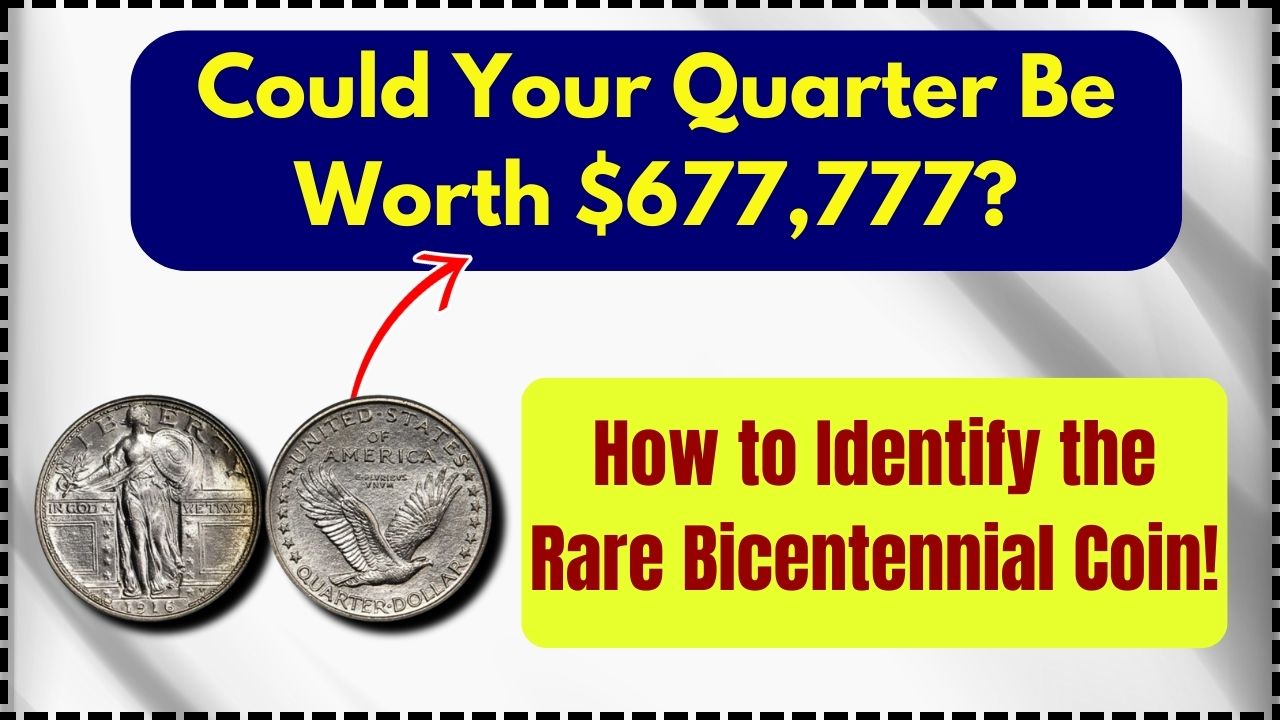Could Your Quarter Be Worth $677,777: Bicentennial quarters are a fascinating piece of American history, minted in 1976 to celebrate the 200th anniversary of the Declaration of Independence. While most of these coins are worth only 25 cents, certain rare versions can be worth an astonishing $677,777 or more! In this guide, we will explore how to identify these valuable quarters, what makes them special, and how you can determine if you have one in your collection.
Could Your Quarter Be Worth $677,777?
| Topic | Details |
|---|---|
| Year of Minting | 1976 (Bicentennial issue) |
| Valuable Quarters | Error coins, silver compositions, special mint marks |
| Highest Known Value | $677,777 |
| How to Identify | Check mint marks, look for errors, verify silver content |
| Official Resource | U.S. Mint Website |
Did you know that some Bicentennial Quarters could be worth up to $677,777? Learn how to identify these rare and valuable coins, including error varieties, silver editions, and high-grade examples.
What Makes a Bicentennial Quarter Rare and Valuable?
1. Unique Design & Historical Significance
Unlike regular Washington quarters, the Bicentennial Quarter features a special drummer boy design on the reverse side, created by Jack L. Ahr. This unique design was chosen through a national competition and was meant to symbolize the spirit of 1776. Additionally, these quarters were only produced for two years (1975 and 1976) and bear the dual date “1776-1976,” making them distinct from standard quarters.
2. Mint Marks and Rarity
The value of a Bicentennial quarter is largely determined by its mint mark and condition. There were three main locations where these coins were minted:
- Philadelphia Mint (No Mint Mark) – Generally common, but some rare varieties exist.
- Denver Mint (“D” Mint Mark) – Also common, but error coins can be valuable.
- San Francisco Mint (“S” Mint Mark) – Struck in both clad proof and 40% silver proof editions, which are more valuable.
- Special Proof Coins – Proof coins from the San Francisco Mint were minted with exceptional quality and often exhibit deep cameo contrast.
3. The $677,777 Bicentennial Quarter – What Sets It Apart?
One of the most valuable Bicentennial Quarters ever sold was a rare error coin that fetched a staggering $677,777 at auction. These types of quarters are highly sought after by collectors due to their scarcity and historical significance.
Here’s what made this particular coin so valuable:
- Double Die Error – Some quarters were struck twice, creating a visible doubling of the letters and numbers.
- Off-Center Strike – A few rare coins were struck off-center, making them unique.
- Silver Composition – The San Francisco Mint produced limited 40% silver Bicentennial quarters, which are significantly more valuable than standard quarters.
- Perfect Condition (MS-70 Grade) – Coins in mint, uncirculated condition are worth far more than those that have been in circulation.
- Die Variety Anomalies – Variations in minting dies can result in minor but valuable differences.
How to Identify a Rare Bicentennial Quarter
Step 1: Check the Mint Mark
- Look just below George Washington’s ponytail on the obverse (front) of the coin.
- If your coin has an “S” mint mark, it could be a valuable silver quarter.
- If it lacks a mint mark, it may still hold value if it exhibits rare errors.
Step 2: Examine the Material Composition
- Standard quarters are made of copper-nickel clad.
- If your quarter has a silvery shine and doesn’t have a copper-colored edge, it could be 40% silver.
- A simple magnet test can also help – silver coins are not magnetic, while standard clad quarters are.
- Weighing the coin (a silver quarter should weigh 5.75 grams, while a clad version weighs 5.67 grams) can confirm composition.
Step 3: Look for Errors
- Double Die Obverse – Check if the inscriptions “LIBERTY” and “IN GOD WE TRUST” appear doubled.
- Off-Center Strikes – If part of the design is missing, it might be a valuable error.
- Die Clash or Cud Errors – Raised or missing portions of the design can make the coin rare.
- Struck Through Grease Errors – Some quarters have missing details due to grease interfering with the striking process.
Step 4: Get It Professionally Graded
- If you suspect your quarter might be valuable, have it graded by a professional coin grading service like PCGS or NGC.
- Coins graded MS-65 or higher are typically the most valuable.
- Certified coins with sealed cases maintain their value over time.
How Much Are Bicentennial Quarters Worth?
| Coin Type | Estimated Value |
|---|---|
| Regular Clad Bicentennial Quarter | $0.25 – $2 |
| 40% Silver Bicentennial Quarter (Uncirculated) | $10 – $50 |
| Proof Bicentennial Quarter (Silver) | $20 – $100 |
| Error Coins (Double Die, Off-Center) | $500 – $10,000+ |
| Rare MS-70 Bicentennial Quarter | Up to $677,777 |
| Deep Cameo Proof Bicentennial Quarter | $50 – $500 |
1964 Kennedy Half Dollar having value of $200,000 – Check if you have one
The $51 Million Rare Bicentennial Quarter – Check these 5 More Coins That Could Be Worth Big Money!
$2,500 Stimulus Payment Update – Is It Coming in February 2025? Check the Facts!
Where to Sell Rare Bicentennial Quarters
If you believe you own a valuable Bicentennial quarter, here are some places to sell it:
- eBay – Great for reaching a wide audience.
- Heritage Auctions – One of the most reputable coin auction houses.
- PCGS or NGC – You can get it graded and sell it directly through their marketplace.
- Local Coin Shops – A good option for a quick sale, but prices may be lower.
- Facebook Marketplace & Coin Collector Forums – A great way to connect with serious collectors.
